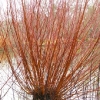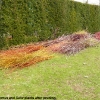Pollarding and coppicing
These are pruning techniques which involve cutting plants either to ground level (coppicing) or to a stump (pollarding). These techniques are used regularly, sometimes annually, and the choice of which to use is often driven by whether only the young growth is required (in which case the old growth is coppiced to ground level) or if a ‘trunk’ is required to bring the younger growth to eye level, or to allow planting underneath the crown. Sometimes the choice between pollarding and coppicing will be driven by what the plant in question will tolerate. Some plants can only be coppiced or pollarded if this is done from a young age; if allowed to become well established first they may not survive the process. Other plants shouldn’t be cut back until they are at least year or two old. Most plants will not survive this treatment at all (it relies on the plant being fairly disease reisistant to fend off any infection of the large cut surfaces). So make sure you check before you head in with your pruning saw!
There are several different reasons for using coppicing or pollarding:
Ornamental stems
Many plants have attractively coloured stems when young, which bring colour to the garden when the leaves have fallen in winter. Coppicing or pollarding keeps the growth young to optimise the winter display. Examples of plants which are coppiced or pollarded for stem effect include:
- Cornus (eg Cornus alba ‘Sibirica’)
- Salix
- Acer pensylvanicum ‘Erythrocladum’
Ornamental foliage
Similar to stem effect, some plants have leaves which are considered to be of greater ornamental value when they are young. This may be because of shape, size or colour of the juvenile foliage. Cutting them back hard ensures that the new season’s leaf growth is from young stems. Plants with attractive juvenile foliage include:
- Ailanthus
- Paulownia
- Eucalyptus (eg Eucalyptus gunnii)
- Catalpa (eg Catalpa bignonioides ‘Aurea’)
- Pawlonia
- Toona sinensis ‘Flamingo’
Restricting size
Pollarding and coppicing can be used to enable gardeners to grow trees which would otherwise be too large for the space available, or where the plant is intended as relatively low, multi-stemmed hedging. However, it should be kept in mind that the restricted top growth will not be reflected by the root system, so you should ensure that you have sufficient space for the underground growth. Plants which respond well to this (and are rather large without it!) include:
- Paulownia
- Catalpa
- Morus alba
- Ailanthus
- Carpinus betulus
- Corylus
- Cercis
- Fagus sylvatica
- Oak (Quercus robur)
Rejuvenation
Coppicing and pollarding can be used as methods for renovation pruning, particularly for large trees which have lost branches due to high winds. On large trees this work should always be carried out by a professional.
Winter protection
Where a plant requires protection over the winter (eg by being covered with straw) coppicing or pollarding can be used to reduce the size of the plant to make covering it easier.
Functional stems
Some plants are cut back to produce young stems for use in hurdles and basketwork, a process which has been used for many centuries. These plants include:
- Salix
- Corylus
How to pollard a plant
Ideally you should select a young plant which has been grown with a single stem and is topped with plenty of lateral growth. If not, you should gradually clear the stem of branches in a similar way to clearing a standard tree’s trunk. Once the plant is established (but before the stem diameter goes over 10cm) and the main, clear stem has reached the required height, you can start to pollard it. In late winter or early spring use a pruning saw to cut off the main stem just above the lowest bunch of lateral growth. Cut back the remaining branches to between 3 and 8cm long.
The next year (or in 2 to 3 years’ time) shorten all the new stems to within 1-2cm of the main stem. Continue to do this every 1 to 3 years. The ‘head’ of the pollarded main stem will enlarge and care must be taken not to damage it. If the stems become overcrowded prune some of them back to the main stem to thin them out.
How to coppice a plant
Coppicing is a much simpler technique. All the stems are cut down to ground level or just above (specific plants may require slightly different heights) every 1 to 3 years in winter or early spring. Make sure any rough edges are trimmed with a sharp knife. If the new growth becomes over-crowded, then take out some of the stems by cutting them down to their base.
Examples of coppiced and pollarded plants:












